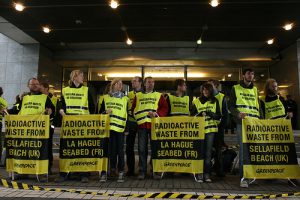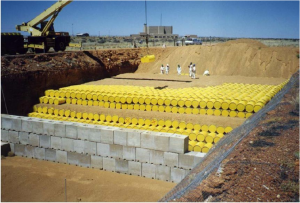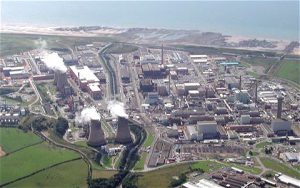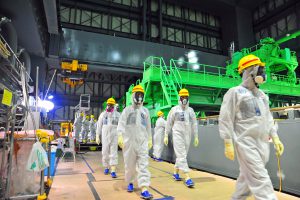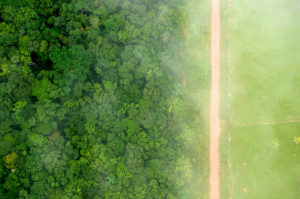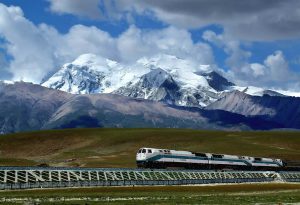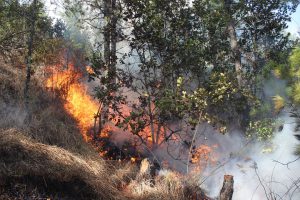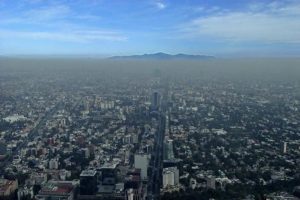Almost a year after the US joined the Second World War, scientists created the world’s first self-sustaining nuclear chain reaction. It happened at the University of Chicago on December 2 1942 in a rather unpromising setting, under a tent on a squash court stuffed beneath the stands at Stagg Field.
That moment, when the first controlled nuclear fission chain reaction was finally achieved, could not have been more auspicious. It led directly to the creation of the atomic bomb, to nuclear power plants and to radioactive waste.
While Enrico Fermi and his team were responsible for the birth of the Atomic Age that day in Chicago, neither they nor anyone else at the time gave thought to the management of the tremendous amount of radioactive waste that was — and continues to be — its legacy. As a result, the long-term management of high-level radioactive waste from nuclear reactors remains a problem that is unsolved today around the world.
Early ideas included a recommendation from the US National Academy of Sciences to abandon radioactive waste in salt mines. A site in Lyons, Kansas, was selected. Explorations began, but within three years the plan was dismissed after it was deemed too scientifically flawed to be worthy of further consideration.
Then came several outlandish notions, some of which managed to get funding, if only for a brief time. These included the use of future Space Age technology to shoot radioactive waste into the sun, or bury it beneath the ocean floor. Mercifully, these ideas were abandoned.
Another proposed solution, reprocessing, was outlawed by the Gerard Ford and Jimmy Carter administrations because they thought it would send the wrong message abroad as the US tried to enforce nuclear non-proliferation.
In the end, the concept of a deep underground geological repository, which had been explored early on by both the US Department of Energy, was settled upon as the solution. Once Congress passed the Nuclear Waste Policy Act, in 1982, the search for a site — or, more accurately, two sites — began in earnest.
Early front-runners included sites in Texas, Washington State and Nevada, a clear indication that this was to be a political — not a scientific or practical — decision. With the vast majority of nuclear power plants east of the Mississippi, it was illogical in the extreme to introduce the risk and expense of transporting a vast proportion of radioactive waste inventory from one side of the country to the other.
The eastern US was briefly considered for a second repository site, specifically the granite state of New Hampshire, which mustered vociferous public and political opposition. In the end, this project was dropped as a Republican-controlled Senate sought to cushion vulnerable candidates up for re-election
In 1987, Congress selected Yucca Mountain in the Nevada desert in what was cynically referred to as the “Screw Nevada” bill. The clause that chose Yucca Mountain as the repository site was written behind closed doors and tucked away within a 2,100-page major spending bill.
Nevada fought back, objecting to the hijacking of its state's right to determine its economic and environmental future. It also asserted the right to either consent or object to federal projects within its borders. Furthermore, State of Nevada scientists believed the geology around the site was clearly unsuitable and that it should have been disqualified from the start.
At least 33 earthquake faults surround the Yucca Mountain site, along with volcanic cinder cones. Subsequent geological studies revealed the presence of water saturation deep underground where the waste would be buried. Not only would the waste casks fail to endure over the centuries that this waste would need to be stored, the geology lacked, the essential barrier, between the stored radioactive waste and the groundwater and drinking water into which it would eventually seep.
The land is also sacred to the Western Shoshone people. But in the end, none of this mattered. Just as it was chosen politically, so Yucca Mountain was eventually rejected, when the powerful Senator from Nevada, Harry Reid, rose to become Senate majority leader.
After more than 30 years and at least US$11 billion of spending, Yucca Mountain remains an abandoned hole in the ground, another tombstone to the unsolved, and potentially unsolvable, problem of radioactive waste. In 2010 the Obama administration moved to abandon the Yucca Mountain dump, officially canceling it in April 2011. Had it gone forward, the projected cost would have been at least US$96 billion.
Consequently, almost all of the high-level radioactive waste produced in the US by commercial nuclear power plants remains stored on site, even at those plants that no longer operate. The reactor buildings themselves may be gone, but the waste casks remain, providing an open invitation to sabotage or attack and vulnerable to leakage, accident or natural disaster.
These risks are of course compounded by the second biggest mistake after the one that gave the green light to atomic energy in the first place. This was the decision to continue to generate radioactive waste, despite the absence of a solution for long-term safeguards and management.
The high-level radioactive waste at reactor sites must remain in the fuel pools for at least five years, before it is thermally cool enough to move into dry cask storage. An accident or attack that could release waste from these fuel pools represents an even greater risk than a reactor core meltdown. This is because the fuel pools sit unprotected outside of containment and accommodate a far higher inventory of radioactivity than the reactor core.
For example, had all the irradiated fuel been released from the Fukushima fuel pools during the 2011 nuclear disaster in Japan, the country would have been looking at a mass evacuation of as many as 50 million people, including the city of Tokyo.
Failed attempt
Nuclear utilities in the US has been paying the Department of Energy for the removal of irradiated reactor fuel since 1983 at a rate of about US$750 million a year. In March 2010, with the waste still in place, nuclear plant owners and their lobbyists, the Nuclear Energy Institute, finally sued. The Obama administration stopped collecting the fee in May 2014 under a court order.
With Yucca Mountain ruled out, the Obama administration set up the Blue Ribbon Commission for America’s Nuclear Future to “solve” the nuclear waste problem. The process lasted a little under two years and came up with nothing really new.
Kicking the can down the road
The Commission settled on ‘Consolidated Interim Storage (CIS),’ another kick the can down the road option that would postpone finding a genuine solution. CIS is effectively a “temporary” parking-lot style waste storage site, a way station while the search continues for a “permanent” solution. Indian reservations are once again threatened, given their often dire economic needs they and vulnerable to the “volunteer” programmes that often cash incenitives.
Despite the cancellation of Yucca however, the US Department of Energy has not given up on a permanent geologic repository. Under the auspices of what it calls a “consent-based siting” process, the DOE intends to find volunteer communities for both temporary and permanent radioactive waste dumps.
Impact of 2016 elections
According to the DOE, “In a consent-based siting approach, DOE will work with communities, tribal governments and states across the country that express interest in hosting any of the facilities identified as part of an integrated waste management system.” How that interest may be sweetened financially remains an open question.
Even Yucca Mountain could rise again. Should a Republican win the White House in November, and with Reid heading for retirement, it could well land firmly back on the table.
‘The least-worst option’
There is one option, however, that has never been considered by any US administration or the DOE. Known as Hardened On-Site Storage, or HOSS, irradiated fuel would remain at reactor sites in dry casks built to last centuries, fortified by mounds made of concrete, steel and gravel to better withstand a range of severe attacks including anti-tank missiles or airliner impacts.
HOSS is strongly supported by more than 200 U.S. anti-nuclear groups representing all 50 states, who nevertheless view it less as a solution than as an interim ‘least worst option’.
Yet despite petitions, Congressional testimony and numerous presentations, HOSS has been routinely shut out of the solutions debate. And the production line of radioactive waste continues unabated.
